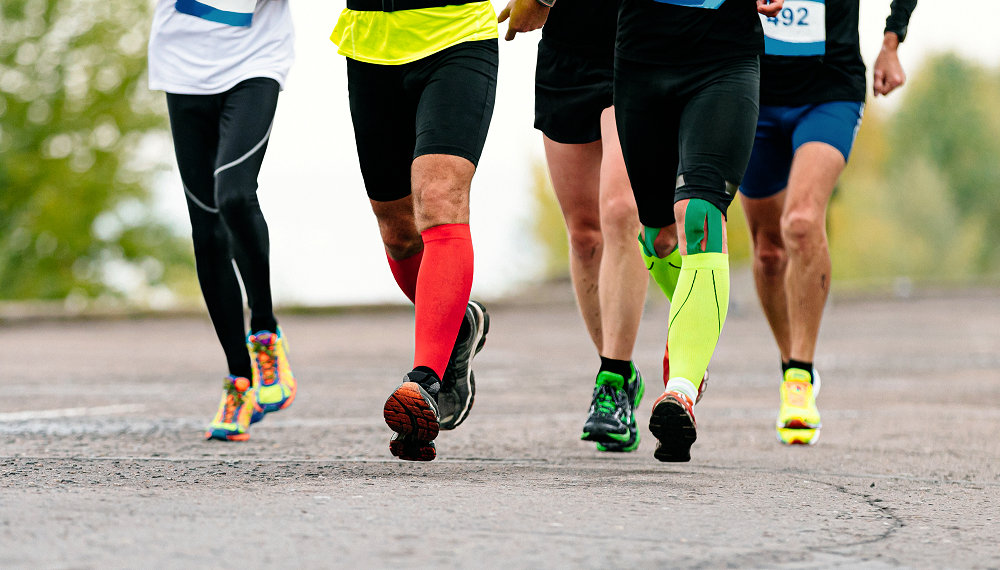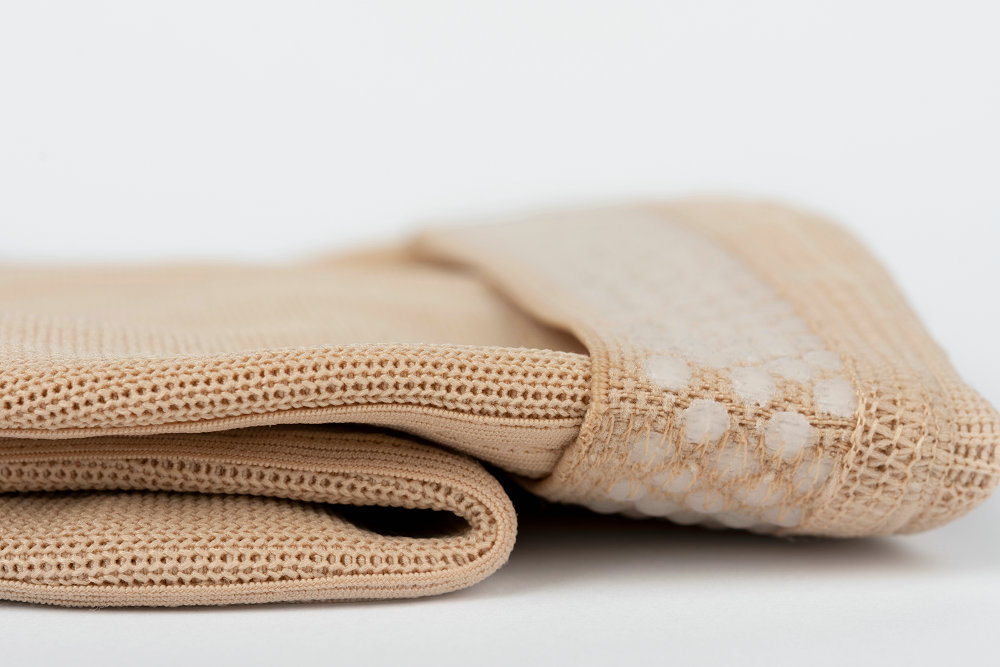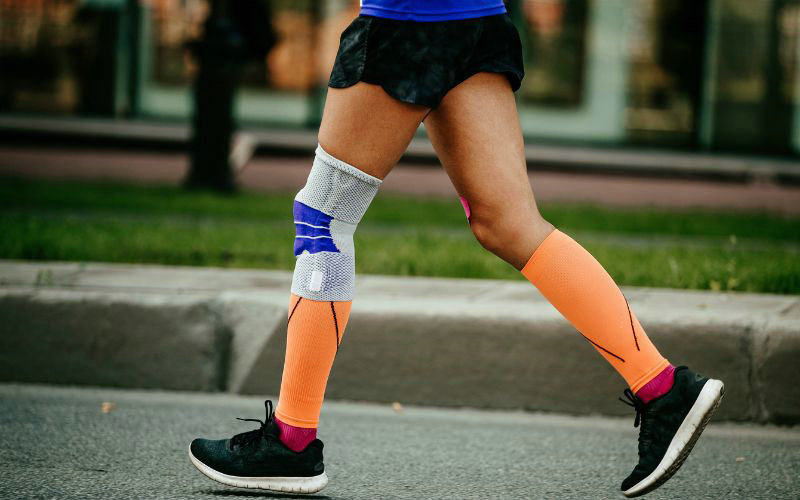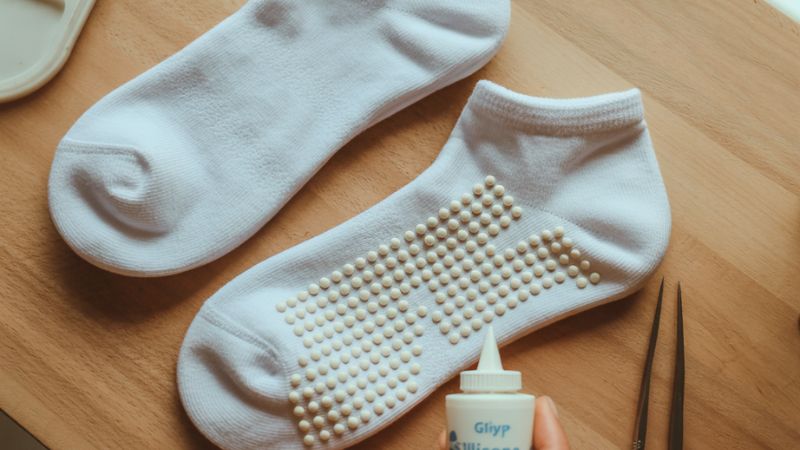Compression socks have become increasingly popular in recent years for their many benefits, including improved circulation, reduced swelling, and decreased risk of blood clots.
However, many people still need to learn how long it takes for compression socks to work and what factors can affect their effectiveness. In this article, we will explore how long does it take for compression socks to work, as well as provide:
- Information on selecting the right size and type.
- Tips for first-time users.
- Recommendations for buying.
Compression socks are a hose designed to provide graduated leg and foot compression. This means the compression is strongest at the ankle and gradually decreases as it moves up the leg.
Compression socks are typically made from a blend of nylon and spandex, which provides a stretchy and supportive fit.

Purpose and Benefits of Compression Socks
The primary reason many wear compression stockings is to improve circulation in the legs and feet. It does this by applying pressure to the veins in the legs, which helps push blood back toward the heart and improve blood circulation.
This can be especially beneficial for individuals who spend much time sitting or standing and those who suffer from varicose veins, deep vein thrombosis, or lymphedema and poor blood flow.
In addition to improving circulation, compression socks can help reduce swelling in the legs and feet and decrease the risk of blood clots. They can also help to improve athletic performance by reducing muscle fatigue and soreness.
Working Mechanism
Compression socks work by applying graduated pressure to the legs and feet. This pressure helps to improve circulation by reducing the diameter of the veins in the legs, which makes it easier for blood to flow back up toward the heart.
The pressure is most substantial at the ankle and gradually decreases as it moves up the leg, which helps to prevent blood from pooling in the feet and lower legs.

Types of Compression Socks
Several types of compression socks are available on the market, each designed to meet different needs and preferences. Some of the most common types include:
• Knee-high socks – cover the entire lower leg, from the knee to the ankle.
• Thigh-high socks – These socks extend up to the thigh, providing full lower-leg coverage.
• Pantyhose – These compression garments cover both the legs and the torso, providing full-body compression.
• Open-toe socks – It has an open toe, which can be more comfortable for individuals with larger or wider feet.
• Closed-toe socks – The closed toe style provides more compression to the foot.

Compression Levels and Style
Compression socks are available in a range of compression levels measured in millimeters of mercury (mmHg). The most common compression levels include:
Mild compression (8-15 mmHg) – This compression level is typically used for individuals who want to improve circulation or reduce mild swelling in the legs and feet.
Moderate compression (15-20 mmHg) – Highly recommended for individuals who suffer from varicose veins, spider veins, or mild edema.
Firm compression (20-30 mmHg) – Ideal for anyone suffering from moderate to severe varicose veins, lymphedema, or deep vein thrombosis.
• Extra-firm compression (30-40 mmHg) – Individuals with severe edema, chronic venous insufficiency, or post-thrombotic syndrome can benefit from the extra firm compression socks.

Various Styles for Different Needs
Compression socks are available in various styles to meet different needs and preferences. Some of the most common styles include:
• Athletic socks – These socks are designed for athletes and active individuals and are often made from moisture-wicking materials to keep feet dry and cool.
• Dress socks – These socks are designed for formal occasions and are often made from dressier materials such as silk or wool.
• Medical-grade socks – Made for individuals with medical conditions such as varicose veins or lymphedema and are often available in higher compression levels.

Factors Affecting Results
The effectiveness of compression socks can be affected by several factors, including the severity of the condition being treated, the compression level of the socks, and the length of time they are worn each day.
It is also important to note that while compression socks can provide immediate relief from symptoms such as swelling and discomfort, it may take several weeks or even months of consistent wear to see more significant improvements in circulation.
Expected Duration for Noticeable Improvements
The time it takes for compression socks to work will vary depending on the individual and the severity of their condition. However, individuals generally expect noticeable improvements in their symptoms within a few days to a few weeks of consistent wear.
Ideal Situations for Use
Compression socks can be used in various situations, including during long periods of sitting or standing, air travel, exercise, and pregnancy. They can also benefit individuals with medical conditions such as varicose veins, lymphedema, or deep vein thrombosis.
Recommended Duration of Wear
The recommended duration of wear for compression socks will depend on the individual and their specific needs. In general, it is recommended that compression socks be worn for at least 8 hours a day to provide maximum benefit.
However, some individuals may need to wear them longer, especially if using them to treat a medical condition.

Who Should Use Compression Socks
Individuals of all ages and activity levels can use compression socks. They are especially beneficial for individuals who spend much time sitting or standing and those who suffer from varicose veins, deep vein thrombosis, or lymphedema.
Who Should Avoid Compression Socks and Potential Risks
While compression socks are generally safe for most individuals to use, there are some situations where they should be avoided.
Individuals with certain medical conditions, such as peripheral artery disease or congestive heart failure, may not be able to tolerate the pressure exerted by compression socks.
We recommend you consult with their healthcare provider before using them. Furthermore, individuals with certain skin conditions or allergies may experience skin irritation from wearing compression socks.
Selecting the Right Size and Type of Compression Socks
Selecting the right size and type of compression socks ensures maximum effectiveness and comfort. It is recommended that individuals measure their legs before purchasing compression socks to ensure a proper fit.
Individuals should consider factors such as compression level, style, and material when selecting compression socks.
Tips for First-Time Users
Get the Right Size
Compression socks come in different sizes, so getting the right size for your feet and legs is essential. Measure your ankle circumference and calf circumference, and use these measurements to choose the right size from the manufacturer’s sizing chart.
Gradually Increase Wear Time
Wear compression socks for short periods, such as an hour or two a day, and gradually increase the wear time as your body adjusts. This can help prevent discomfort and ensure that the socks are effective.
Put them on Correctly
Turn the sock inside out and insert your foot to put on compression socks. Gradually pull the sock up over your calf, smoothing out any wrinkles or bunching as you go. Please ensure the socks are snug but not too tight, and adjust them as needed.
Wear them Consistently
For compression socks to be practical, it’s essential to wear them consistently. Wear them daily or as often as your healthcare provider or manufacturer recommends.
Keep them Clean
Wash your compression socks according to the manufacturer’s instructions. Some socks can be machine washed, while others should be hand washed. Avoid using fabric softener or bleach, as these can damage the socks.
Replace them Regularly
Compression socks can lose their elasticity over time, so it’s important to replace them regularly. Follow the manufacturer’s recommendation for when to replace your socks, or replace them sooner if you notice any signs of wear or tear.
Proper Way to Wear Compression Socks
Compression socks should be worn snugly but not too tight. Pulling the socks up slowly and evenly ensures no wrinkles or bunching. It’s important to take breaks from wearing socks for too long so that your skin can breathe.
Dispelling Myths about Compression Socks
There are several myths surrounding compression socks that are important to dispel. One common myth is that compression socks are only for older people.
However, compression socks can benefit individuals of all ages, especially those who are physically active or spend a lot of time sitting or standing.
Another common myth is that compression socks are uncomfortable to wear. While some individuals may initially find compression socks uncomfortable, proper sizing and gradual wear can help increase comfort over time.

Frequently Asked Questions
Some common questions about compression socks include the following:
How long should compression socks be worn each day?
Can compression socks be worn during exercise?
Can compression socks be worn during air travel?
Buying Recommendations
When it comes to buying compression socks, here are some recommendations to consider.
Compression Level: Compression socks come in different compression levels, typically measured in millimetres of mercury (mmHg). The level of compression you need will depend on your needs and any medical conditions.
Material: Compression socks are made from nylon, spandex, and polyester. Look for socks made from high-quality materials that are breathable and moisture-wicking to help keep your feet and legs comfortable and dry.
Comfort Features: Look for compression socks with features that enhance comfort, such as a cushioned sole, a seamless toe, and a non-binding top band. These features can help prevent irritation and chafing and provide a comfortable fit.
Size and Fit: Make sure you choose the right size and fit for your feet and legs, as a poorly fitting sock can be uncomfortable and ineffective. Refer to the manufacturer’s sizing chart, and measure your ankle and calf circumference to ensure a proper fit.
Style: Compression socks come in various styles and colors, so you can choose a sock that fits your style and preferences. Some socks may be more discreet, while others may be more colourful and bold.
Brand Reputation: Look for compression socks from reputable brands with a record of producing high-quality compression garments. Read reviews and ask for recommendations from others who have used compression socks.
Importance of Choosing Quality Products
Choosing high-quality compression socks is essential for ensuring maximum effectiveness and comfort. Low-quality socks may not provide the proper compression level or may wear out quickly, reducing their effectiveness over time.
Conclusion
Compression socks help improve circulation and reduce symptoms such as swelling and discomfort. With proper selection and use, individuals can experience noticeable improvements in their symptoms within a few days to a few weeks of consistent wear.
Understanding the different types and styles of compression socks and the factors that can affect their effectiveness is important. Individuals can improve their quality of life and overall health by making informed decisions about compression socks.
To order high-quality compression socks in wholesale, please fill out our contact form.



